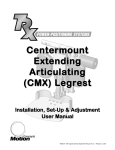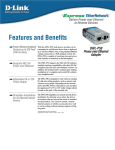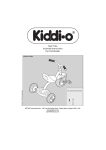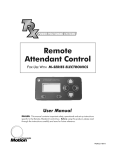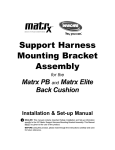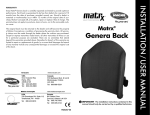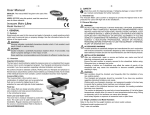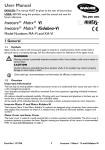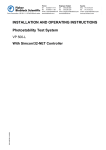Download TRx LNX Power Center Mount Foot Platform
Transcript
LNX Power Centermount Legrest Installation, Set-Up & Adjustment User Manual TRD0282- LNX Centermount Legrest Set-Up/ Adjustment Manual, Rev 2.0- September 8, 2010 -2- -3- i Impor tant! The most important link in the delivery chain is the end user. The user must be satisfied with the product in terms of function, safety and aesthetics. No sale is complete unless the end user receives thorough training in all aspects of the care and use of the system. A complete instruction session with your customer is essential. Only the dealer and the health care professional can ensure that the system is set up properly and safely for the specific needs of the individual user. Training Installation and set-up of the LNX Centermount Legrest must only be performed by a trained technician or healthcare professional. If you are not certified as an installer, please arrange immediately for training by a Motion Concepts Technician or Sales Representative. Every effort will be made to meet your training needs. Note: Before proceeding with the installation/ set-up, please ensure that no pages are missing from this manual. Tools The following tools are required for the installation/ set-up of the LNX Legrest: Wrenches: 7/16”, 1/2” Socket wrenches: 7/16”, 1/2” Allen keys: 3/16”, 1/4”, 1/8” Screw Drivers -4- 1 . 0 - A s s e m b l y O ve r v i e w D r a w i n g s -5- 1 . 0 - A s s e m b l y O ve r v i e w D r a w i n g s L N X Center mount Le g r est Assemb l y (shown with Individual (Split) Footplates) Malle able Calf P ad Indep end Curv ent e Calf d Pads (Opti onal) (Note: Legrest Receivers are not shown) -6- 1 . 0 - A s s e m b l y O ve r v i e w D r a w i n g s L N X Center mount Le g r est Assemb l y (shown with Centermount Foot Platform) Malle able Calf P ad Indep end Curv ent e Calf d Pads (Opti onal) (Note: Legrest Receivers are not shown) -7- 2 . 0 - L N X L e g r e s t I n s t a l l a t i o n O ve r v i e w i) LNX Centermount Legrest Installation Overview The LNX Centermount Legrest is installed into the seat frame (not shown) of the upper seating system via the adjustable depth legrest receivers (Figure 1.0). The initial angle (fully retracted position) of the LNX Legrest can be set to one of three optional configurations. By changing the mounting holes used in the upper legrest mount (tube), the initial legrest angle can be varied (as indicated in Figure 1.0 below). The LNX Legrest may be configured with either individual (split) footplates (see Figure 2.0, p.8), or a centermount platform (Figure 3.0, p.8), and is designed to provide infinite knee-to-heel (KTH)1 adjustment within the established range of the extension brackets. There are two sizes of extension brackets available: SHORT (LIMITED) = 13” to 15-1/2” KTH range ; LONG = 13” to 19” KTH range 1 note: KTH height is measured from top of seat pan to the top of the footplate. The unique design of the LNX legrest uses geometry instead of sliding tubes or complicated linkages to provide virtual articulation of up to 8.25". The overall range of travel (final legrest angle) can be adjusted to best meet the needs of the end user, and will vary depending on the initial legrest angle. Both footplate options allow adjustment to the footplate angle, while the split footplates also allow for offset positioning of the two footplates (i.e.; bi-level installation) The sections that follow provide greater detail on the installation, assembly and proper set-up of the LNX Legrest. INITIAL LEGREST ANGLE SET-UP* A. INSTALLS INTO SEAT FRAME A. Initial Angle (+7°) B. Initial Angle (90°) B. legrest receiver C. Initial Angle (-7°) C. *When Legrest is Fully Retracted (Long Bracket shown) Unique legrest geometry provides virtual articulation up to 8.25” Note: The range of travel can be adjusted/ customized to meet the needs of the end user. The final legrest angle (at full extension) will vary depending on the intial legrest angle EXTENDED POSITION Figure 1.0 -8- 2 . 0 - L N X L e g r e s t I n s t a l l a t i o n O ve r v i e w Figure 2.0 LNX Legrest Assembly w/ Split Footpla tes BI-LEVEL Footplate Configuration Retracted Position UNI-LEVEL Footplate Configuration Figure 3.0 LNX Legrest Assembly w/ Center mount Pla tf or m -9- 3.0 - LNX Le g rest Set-Up and Adjustment LNX LEGREST : Basic Set-Up & Adjustments The basic set-up of the LNX Legrest can be performed in two simple steps (refer to Figure 4 below): Step A : With the client properly seated in the chair, adjust the knee-to-heel (KTH) of the legrest assembly to optimize the comfort/ positioning of the clients legs (refer to). Once the KTH is set, the legrest should then be fully extended with the client still seated in the chair. Step B : While extended, loosen the legrest receivers locking screws and carefully slide the entire legrest assembly inward or outward (as needed) so that the footplate just makes contact with the clients feet1 (Refer to p.12 for additional Depth Adjustment instructions). Re-tighten the legrest receivers to secure the LNX legrest assembly into position. 1 Important! when the legrest is fully extended, ensure the clients feet are supported at the heel by the footplate, in addition to the leg support provided by the calf pad. It may be necessary/ desireable to make additional adjustments to the legrest assembly to meet the specific needs of the client. Steps C. thru E. illustrate the additional adjustments available on the LNX Legrest. A . Knee-to-Heel (KTH) Set-Up/ Adjustment: KTH set-up is controlled via the legrest extension bracket. The split footplates utilize two individual extension brackets (to allow independent footplate adjustment), while the centermount foot platform utilizes a onepiece extension bracket. The slotted channel in the bracket allows for infinite KTH adjustability within the available channel length. Extension Brackets: S HOR T KTH = 13” to 15-1/2” ; L O N G K T H = 13” to 19” - see Figure 4.0 below Note: KTH length is measured from top of seat pan to the top of the footplate. i Important! ALWAYS maintain a minimum of 3-inches between bottom of the front riggings and the floor/ground while the wheelchair is in motion to ensure proper ground clearance. If necessary, elevate the front rigging or tilt seat to achieve proper ground clearance. Warning! DO NOT leave elevating legrests in the fully extended position when proceeding down ramps or slopes. Figure 4.0 Knee-to-Heel Adjustments Le g r est De pth Adjustment A. B. Range of Adjustment (13” - 19”) Range of Adjustment (13” - 15.5”) SHORT (Limited KTH) Legrest Extension Brackets LONG maintain a minimum 3” ground clearance - 10 - 3.0 - LNX Le g rest Set-Up and Adjustment A . Knee-to-Heel Adjustments (... cont’d) i. I. S plit Footplate (Uni-Level Adjustments) Each individual footplate is installed onto its own separate extension bracket. For the shortest KTH lengths (13” up to 13-1/2”) the spacer block is not required, and only two sets of screws are required to install/adjust the footplates along the extension brackets (refer to image i and ii). For longer KTH lengths (13-1/2” to 19”) the KTH length is adjusted via the upper 2 screws on the extension bracket (refer to image i.) To maintain strength and stability at longer KTH settings, the spacer block must be installed at the bottom of the extension bracket (aligned between the footplates). 13” up to 13-1/2” KTH Length Shortest KTH (utilizes 2 screws only) Loosen both screws on the left & right extension brackets to adjust the KTH length Screws *Spacer Block Removed Note: Front shroud & calf pads are not shown for illustration purposes. ii. iii. Spacer Block Short Bracket Screws Screws Long Bracket 13-1/2” to 15-1/2” KTH Length *Note: to set the lowest KTH length (13” up to 13-1/2”) the spacer block (and hardware) must be removed. 13-1/2” to 19” KTH Length The KTH length is adjusted by loosening the two upper screws on the left & right extension brackets. Control the footplate position (height) via the slotted channels in the brackets. II. S plit Footplate (Bi-Level Adjustments) The separate extension brackets allow each footplate to be adjusted independently for bi-level (offset) configurations. For bi-level set-up, it is recommended that the footplates be first set to the shortest KTH height. With the shorter KTH set, adjust the applicable footplate to the longer KTH position by loosening all 4 screws (see Figures 5a and 5b). Slide (adjust) the footplate/extension bracket to the desired KTH length and re-tighten all 4 screws to secure the footplate into place. Important! In a bi-level configuration, the spacer block should remain aligned with the higher footplate (i.e.; shortest KTH)- as indicated in Figure 5b. Figure 5b. Figure 5a. Adjust the offset footplate/ bracket to desired KTH length and re-tighten screws loosen 2 upper screws Note: Front shroud and calf pads are not shown for illustration purposes Individual Footplate spacer block Loosen lower screws in the spacer block Refasten spacer block at the shorter KTH - 11 - 3.0 - LNX Le g rest Set-Up and Adjustment A. Knee-to-Heel Adjustments (... cont’d) Figure 6b III. Centermount Foot Platform The centermount foot platform is installed onto a onepiece extension bracket. For the shortest KTH lengths (13” up to 13-1/2”) the spacer block is not required, and only two sets of screws are required to install/ adjust the footplates along the extension brackets (refer to Figure 6a). For longer KTH lengths (13-1/2” to 19”) the upper set of screws is used to adjust the extension bracket/ KTH length (see Figure 6b). Note: Front shroud and calf pads are not shown for illustration purposes. Figure 6a 13 to 15-1/2” KTH Length Screws Spacer Block Installed Long KTH Loosen upper screws (x2) to adjust extension bracket/ KTH length 13” up to 13-1/2” KTH Length Screws Shortest KTH (2 sets of screws only) 13 to 19” KTH Length Spacer Block Removed i Important! ALWAYS maintain a minimum of 3-inches between bottom of the front riggings and the floor/ground while the wheelchair is in motion to ensure proper ground clearance. If necessary, elevate the front rigging or tilt seat to achieve proper ground clearance. Warning! DO NOT leave elevating legrests in the fully extended position when proceeding down ramps or slopes. IV. Cosmetic Trim Each LNX legrest comes with a strip of Cosmetic Trim that can be installed in order to cover the exposed edges along the extension bracket, and improve the overall aesthetics of the LNX legrest. To Install: Once the final KTH length is determined, cut the cosmetic trim to the desired length and press the strip into the slots at the front of the spacer block and the main body (extrusion). Refer to image v. below. Cosmetic Trim Main Body Trim Installed Spacer Block v. Measure and cut trim to length Press trim into place - 12 - 3.0 - LNX Le g rest Set-Up and Adjustment B . Legrest Depth Adjustment: Depth adjustment for the LNX Legrest assembly is controlled via the depth adjustable legrest receivers (x2). To adjust the legrest depth, loosen the locking screw on the seat side frame for each of the legrest receivers (left & right). The adjustable depth legrest receivers offer infinite depth adjustment within the available channel length on the legrest receiver (see image vi. at right). vi. Seat Cushion locking screw LNX Legrest seat frame legrest receiver C . Calf Pad Adjustments: I. Malleable Calf Panel (Standard) The malleable calf panel provides a greater level of support without the need for a multitude of adjustments. This unique one-piece calf panel utilizes a bendable steel ‘inner skeleton’ that is molded directly into the foam pad. The calf panel can be manipulated/shaped (by hand) to match the contour of the clients legs. The malleable calf panel installs in a fixed position on the legrest assembly. Refer to Figures 7a & 7b. Fixed Mounting Position (2 screws) Malleable Calf Panel bendable steel inner skeleton Figure 7b Figure 7a II. Independent Curved Calf Pads (Optional) The overall height/ position of the curved calf pads on the legrest assembly can be adjusted via the calf pad mounting plate (both pads are adjusted at once)- see Figure 8.0 below. To adjust the mounting position of the calf pads, loosen the two mounting screws on the front shroud cover, and slide the calf pads up or down via the slot in the mounting plate. The mounting plate provides a 1-1/4” range of vertical adjustment. . Independent Curved Calf Pad . Calf Pad Mounting Plate height adjustment Figure 8.0 To adjust calf pad height, loosen both screws and slide the calf pad assembly into the desired position (both pads adjust simultaneously) - 13 - 3.0 - LNX Le g rest Set-Up and Adjustment C . Calf Pad Adjustments: (...cont’d) The independent curved calf pads are installed via a mounting bracket into the tab on the side of the calf pad mounting plate. The calf pads may be configured (independently) in one of three positions on the mounting plate: in the standard position; in a forward position, or in the rearward (inverted) position (by rotating the mounting bracket 180degrees) - refer to Figure 9.0 below. Calf Pad/ Bracket Adjustment Calf Pad Calf Pad Rearward Mounting 3/4” Inverted Bracket* REAR VIEW mount ing plate Figure 9.0 3/8” Standard Mounting Calf Pad Forward Mounting mount ing bracke t *Note: For the inverted bracket configuration, the calf pad most be removed and re-installed on the opposite side of the mounting bracket Calf Pad/ Bracket Installation Curved calf pads may also be adjusted independently on their respective mounting bracket using the mounting screws at the rear of the calf pads. The calf pads may be mounted in numerous configurations to ensure a high level of comfort for the client- sample configurations are illustrated below in Figure 10.0. Independent Calf Pad Adjustment (Sample Configurations) Figure 10.0 Raised Offset Centered Extended Position (maximum) Lowered Offset Angled D . Footplate Angle Adjustments The Split Footplates (Bi-Level or Uni-Level) can be independently adjusted to set the desired footplate angle for each footplate. The angle of the Center Mount Platform is also adjusted via a set-screw at the rear of the foot platform. Once set, these footplate angles will remain consistent throughout the extension and retraction of the legrest assembly. - 14 - 3.0 - LNX Le g rest Set-Up and Adjustment D . Footplate Angle Adjustments (...cont’d) I. S plit Footplate- Angle Adjustment The angle* of each individual footplate is adjusted via the set screw in the mounting bracket at the rear of each footplate (Refer to Figures 11a and 11b). To set the maximum upward footplate angle, fully extend the set screw (ensure there is adequate screw thread remaining in the footplate to hold it in place). To maximize the downward footplate angle, the set screw may be completely removed. *Note: The final attainable angle of the footplate will be dictated by the initial angle set up of the LNX Legrest - see Section 2.0, p.7 Footplate Angle Adjustment Maximized Upward Angle (with set screw fully extended) 25ο range (approx.) Set Screw INSIDE VIEW (left footplate) Figure 11a Maximized Downward Angle (with set screw removed) Figure 11b II. S plit Footplate- W idth Adjustment The width of each individual footplate can be adjusted relative to its corresponding extension bracket by varying the orientation of the mounting hardware. The adjustable mounting hardware consists of a main bolt and four (4) 1/4” spacers (see Figure 12.0). Each footplate may be adjusted independently by changing the location/ position of the spacers along the mounting bolt- as illustrated in images i. - v. below. Figure 12.0 e.g.; Width Adjustment Extension Bracket (+1/4”) 1/4” Spacers i. Standard (Narrow) Short KTH model shown ii. Medium Narrow (+1/4” per side) iii. Medium (+1/2” per side) iv. Medium Wide (+3/4” per side) v. Wide (+1” per side) - 15 - 3.0 - LNX Le g rest Set-Up and Adjustment III. Centermount Platform- Angle Adjustment The angle* of the centermount platform is determined by an adjustable set screw at the rear of the platform (Refer to Figures 13a and 13b). To set the maximum upward footplate angle, fully extend the set screw (ensure there is adequate screw thread remaining in the foot platform to hold it in place). To maximize the downward foot platform angle, the set screw may be completely removed. Figure 13a Foot Platform Angle Adjustment *Note: the final angle of the foot platform will be dictated by the initial angle set up of the LNX Legrest- see Section 2.0, p.7 Figure 13b Maximized Upward Angle (set screw fully extended) Set Screw 22ο range (approx.) Maximized Downward Angle (set screw removed) TOP VIEW E. Legrest Actuator Limit Adjustments The limit adjustments for the legrest actuator are intended for fine tune adjustments to the overall range of motion of the LNX Legrest. These minute adjustments can be used to eliminate potential interference issues when the legrest is fully retracted, or can be used to decrease the maximum extension if needed. The legrest actuator is equipped with two built-in limit sensors - refer to image vii. below. The upper sensor limit will allow for approximately 4ο (degrees) of adjustment; while the lower (down position) limit allows for approximately 8ο (degrees) of adjustment. To Adjust: Using an allen key, loosen and slide the limit switch along its designated slot to adjust the limit (as illustrated below). Note: the limit adjustments are very sensitive; it is recommended to make a small adjustment and re-cycle the actuator to determine the extent of adjustment. Down Limit Upper Limit Down Limit Switch (at retraction) increases retraction decrease extension decreases retraction increases extention vii. Upper Limit Switch (at extention) USA 700 Ensminger Rd. Suite 112 Tonawanda, NY, USA 14150 716-447-0050 888-433-6818 Canada 84 Citation Dr. Units 1-3 Concord, Ontario, Canada L4K 1C9 905-695-0134 www.motionconcepts.com
















